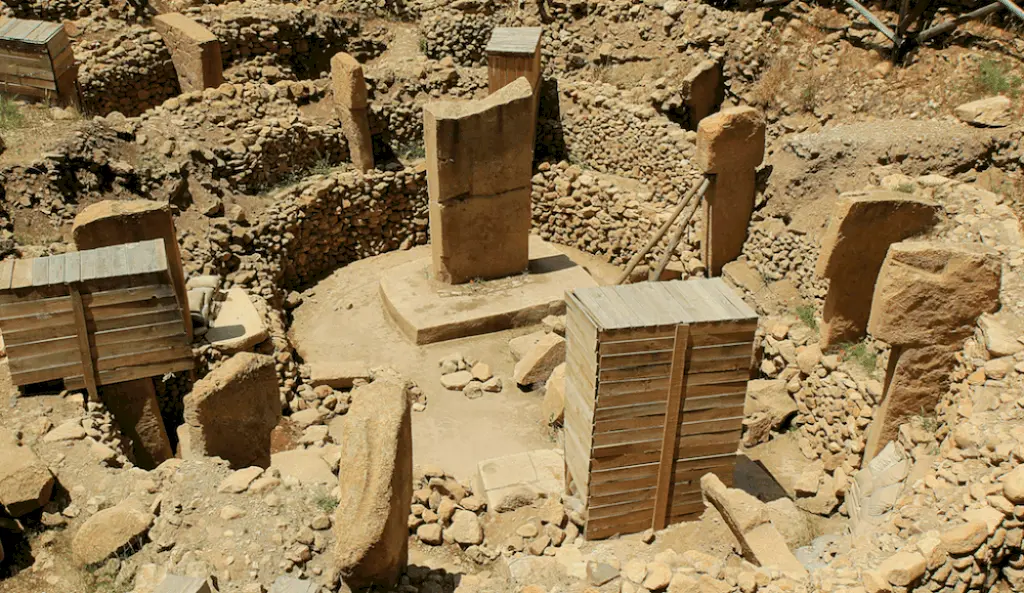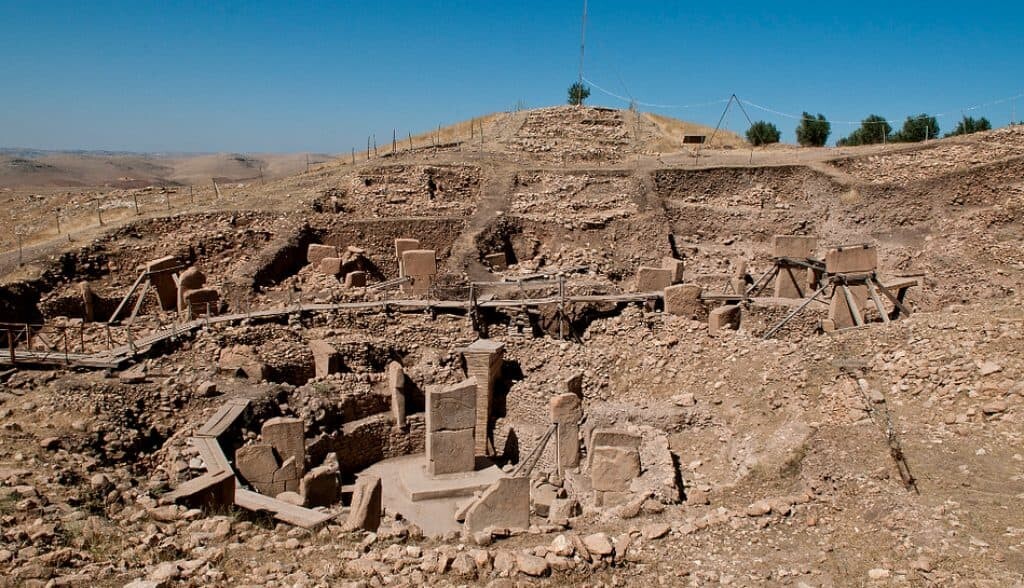Roughly six miles outside of Urfa, Turkey, called Göbekli Tepe. The most impressive and mysterious finding at this site are the megalithic pillars that date as far back as 10,000 BCE. That would make this ancient site the oldest known temples in the world. Archaeologists believe the circular formations are constructions of temples that were used for ritual ceremonies or worship.

One circle of Göbekli Tepe. Source: Wikimedia Commons, Klaus-Peter Simon
Two universities discovered the site in 1963 when they surveyed the area and found the tops of the pillars and flints in the area. In 1994, Klaus Schmidt (now deceased), of the German Archaeological Institute, began excavations on Göbekli Tepe. He had been assisting in the excavations of the nearby site of Nevalı Çori, but he was interested in finding another site to lead a dig. As it turned out, Göbekli Tepe was similar to the other site. Nevalı Çori was an entire village that contained homes as well as temple pillar sites like those found in Göbekli.
Archaeological Discoveries
Since that time, Klaus and his team have uncovered at least seven large stone circles, however, ground-penetrating sensing techniques have mapped out around 200 pillars in 20 circular areas. What are these stones doing in this hill overlooking what must have once been a lush valley? Who built them? Why did they build them and when precisely were they built? Most of these questions have only half-answers and educated guesses.

Göbekli Tepe complex built on a hilltop, 9,000 BC. Source: Flickr, CC.
The largest megaliths found at the site are roughly 16 ft. tall and weigh as much as 10 tons. They are T-shaped, very much like the megalithic Taulas in Menorca. The pillars sit in circular formations with two larger versions of the outer stones in the center of the circles. The ancient people built and buried the formations in layers. There are 3 layers in total.
Some of the pillars have intricate carvings of birds, snakes, scorpions, big cats, and hoofed animals on them. It is surprising that the tools they used were quite primitive, yet they were able to accomplish a fair amount of precision. Interestingly, some archaeologists believe the pillars may represent humans because a number of them have arms carved into the sides. Others believe the statues represent venerated ancestors or gods with human-like features.
Who Built the Temple Sites?
Judging by the animal bones found, the ancient people who erected the site were nomadic hunter-gatherers. That means they were not the type of people to settle down in large groups and build monuments, temples or even elaborate gravesites. At least, that is what experts once thought. The traditional line of thinking is that agriculture (the planting of crops and herding of animals) was the catalyst for such building. If Klaus Schmidt and his team are correct, this no longer holds true. Klaus has done some carbon dating of items unearthed at the Göbekli site, and he has compared some of the tools there to others found in the general area to ascertain the age of the site. What he found is astounding.
It appears that Göbekli Tepe predates ancient wonders like the Pyramids of Giza and Stonehenge by thousands of years. These Turkish formations are roughly 11,000 years old (from around 9000 BCE), according to Klaus’ estimations. This age makes sense considering the tools found at the site and the lack of evidence that people lived here. In other words, the ancients may have used the site strictly for ceremonial purposes. A settlement would have been impractical for people of that time. Also, there are no remains of cooking fires and other evidence of settlement.
Why Was it Built?
What reason could these ancient people have possibly had for building, preserving, and continuing construction on such a site for so long? Klaus Schmidt believes it may have been a place of religious worship. Other theories include an ancient gravesite for important people or a meeting place for local nomadic tribes. The ancient people of this area built up the temples over the course of hundreds of years, possibly even longer. They built stone circles, buried them, and then carried on their work as before. They eventually built the site up into the hill that exists there today.
Was Göbekli Tepe the Garden of Eden?
Some people theorize that the age and location of this site indicate that it was the Biblical Garden of Eden. If it was a place of religious worship, this would make it the oldest temple in the world. Of course, that only leads to more questions. If the Turkish megalithic site really is the site of the Garden of Eden, why did the ancients bury it?
Stonehenge: A Megalithic Monument of Britain’s Ancient People
Chances are that most of the answers to these questions will forever remain a mystery. The early people of this area had no written language, so they left a few clues for us. However, perhaps the ultimate joy of archaeology and mysteries does not come from answering all of our questions. It comes from digging, unearthing, theorizing, and in the questioning.
Sources:
Smithsonian Magazine
Archaeology.org